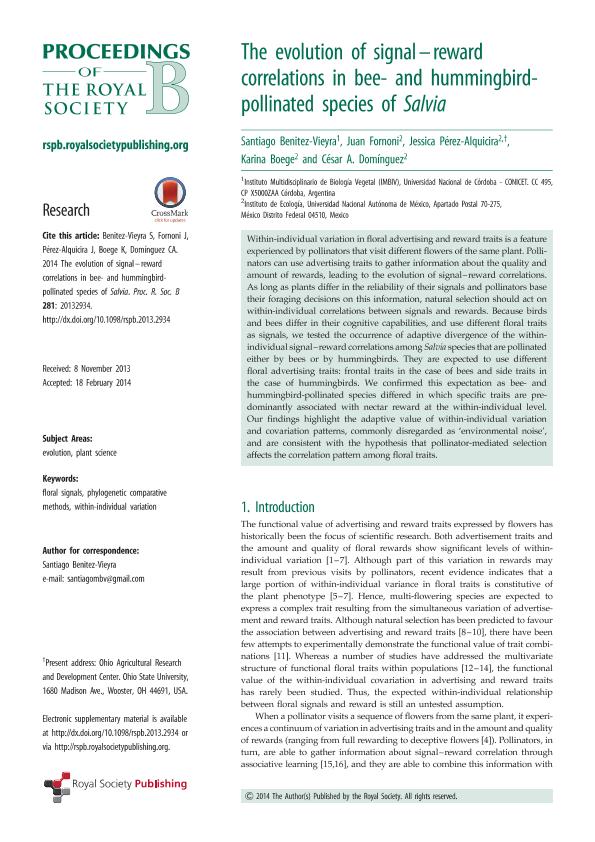Mostrar el registro sencillo del ítem
dc.contributor.author
Benitez-Vieyra, Santiago Miguel

dc.contributor.author
Fornoni, Juan
dc.contributor.author
Pérez Alquicira, Jessica
dc.contributor.author
Boege, Karina
dc.contributor.author
Domínguez, César
dc.date.available
2017-01-05T18:27:07Z
dc.date.issued
2014-03
dc.identifier.citation
Benitez-Vieyra, Santiago Miguel; Fornoni, Juan; Pérez Alquicira, Jessica; Boege, Karina; Domínguez, César; The evolution of signal-reward correlations in bee- and hummingbirdpollinated species of Salvia; The Royal Society; Proceedings of the Royal Society of London. Series B: Biological Sciences; 281; 1782; 3-2014; 1-7
dc.identifier.issn
0962-8452
dc.identifier.uri
http://hdl.handle.net/11336/10882
dc.description.abstract
Within-individual variation in floral advertising and reward traits is a feature experienced by pollinators that visit different flowers of the same plant. Pollinators can use advertising traits to gather information about the quality and amount of rewards, leading to the evolution of signal-reward correlations. As long as plants differ in the reliability of their signals and pollinators base their foraging decisions on this information, natural selection should act on within-individual correlations between signals and rewards. Because birds and bees differ in their cognitive capabilities, and use different floral traits as signals, we tested the occurrence of adaptive divergence of the withinindividual signal-reward correlations among Salvia species that are pollinated either by bees or by hummingbirds. They are expected to use different floral advertising traits: frontal traits in the case of bees and side traits in the case of hummingbirds. We confirmed this expectation as bee- and hummingbird-pollinated species differed in which specific traits are predominantly associated with nectar reward at the within-individual level. Our findings highlight the adaptive value of within-individual variation and covariation patterns, commonly disregarded as 'environmental noise', and are consistent with the hypothesis that pollinator-mediated selection affects the correlation pattern among floral traits.
dc.format
application/pdf
dc.language.iso
eng
dc.publisher
The Royal Society

dc.rights
info:eu-repo/semantics/openAccess
dc.rights.uri
https://creativecommons.org/licenses/by-nc-sa/2.5/ar/
dc.subject
Floral Signals
dc.subject
Phylogenetic Comparative Methods
dc.subject
Within-Individual Variation
dc.subject.classification
Biología

dc.subject.classification
Ciencias Biológicas

dc.subject.classification
CIENCIAS NATURALES Y EXACTAS

dc.title
The evolution of signal-reward correlations in bee- and hummingbirdpollinated species of Salvia
dc.type
info:eu-repo/semantics/article
dc.type
info:ar-repo/semantics/artículo
dc.type
info:eu-repo/semantics/publishedVersion
dc.date.updated
2016-12-12T14:17:59Z
dc.journal.volume
281
dc.journal.number
1782
dc.journal.pagination
1-7
dc.journal.pais
Reino Unido

dc.journal.ciudad
Londres
dc.description.fil
Fil: Benitez-Vieyra, Santiago Miguel. Consejo Nacional de Investigaciones Científicas y Técnicas. Centro Científico Tecnológico Córdoba. Instituto Multidisciplinario de Biología Vegetal (p); Argentina
dc.description.fil
Fil: Fornoni, Juan. Universidad Nacional Autónoma de México; México
dc.description.fil
Fil: Pérez Alquicira, Jessica. Universidad Nacional Autónoma de México; México
dc.description.fil
Fil: Boege, Karina. Universidad Nacional Autónoma de México; México
dc.description.fil
Fil: Domínguez, César. Universidad Nacional Autónoma de México; México
dc.journal.title
Proceedings of the Royal Society of London. Series B: Biological Sciences

dc.relation.alternativeid
info:eu-repo/semantics/altIdentifier/doi/http://dx.doi.org/10.1098/rspb.2013.2934
dc.relation.alternativeid
info:eu-repo/semantics/altIdentifier/url/http://rspb.royalsocietypublishing.org/content/281/1782/20132934
Archivos asociados
